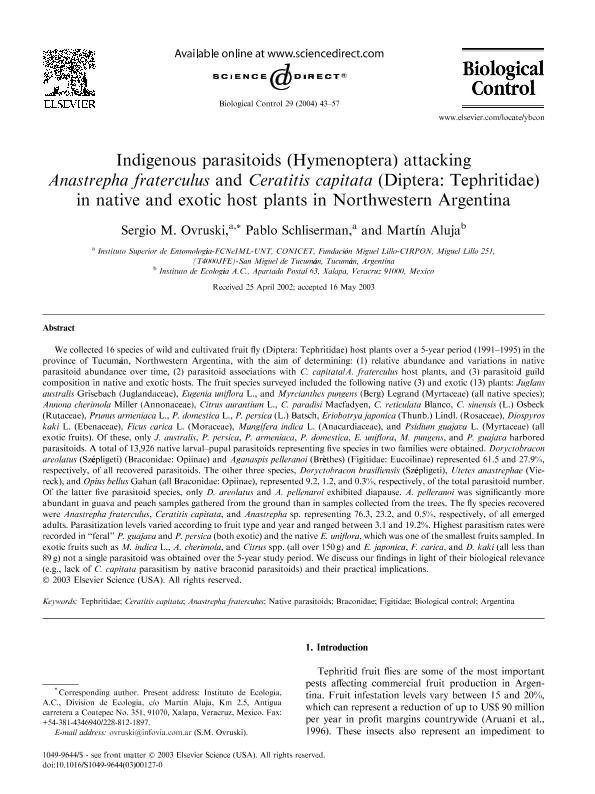Mostrar el registro sencillo del ítem
dc.contributor.author
Ovruski Alderete, Sergio Marcelo

dc.contributor.author
Schliserman, Pablo

dc.contributor.author
Aluja, Martín
dc.date.available
2018-04-11T16:03:36Z
dc.date.issued
2004-12
dc.identifier.citation
Ovruski Alderete, Sergio Marcelo; Schliserman, Pablo; Aluja, Martín; Indigenous parasitoids (Hymenoptera) attacking Anastrepha fraterculus and Ceratitis capitata (Diptera: Tephritidae) in native and exotic host plants in Northwestern Argentina; Academic Press Inc Elsevier Science; Biological Control; 29; 1; 12-2004; 43-57
dc.identifier.issn
1049-9644
dc.identifier.uri
http://hdl.handle.net/11336/41717
dc.description.abstract
We collected 16 species of wild and cultivated fruit fly (Diptera: Tephritidae) host plants over a 5-year period (1991-1995) in the province of Tucumán, Northwestern Argentina, with the aim of determining: (1) relative abundance and variations in native parasitoid abundance over time, (2) parasitoid associations with C. capitata/A. fraterculus host plants, and (3) parasitoid guild composition in native and exotic hosts. The fruit species surveyed included the following native (3) and exotic (13) plants: Juglans australis Grisebach (Juglandaceae), Eugenia uniflora L., and Myrcianthes pungens (Berg) Legrand (Myrtaceae) (all native species); Annona cherimola Miller (Annonaceae), Citrus aurantium L., C. paradisi Macfadyen, C. reticulata Blanco, C. sinensis (L.) Osbeck (Rutaceae), Prunus armeniaca L., P. domestica L., P. persica (L.) Batsch, Eriobotrya japonica (Thunb.) Lindl. (Rosaceae), Diospyros kaki L. (Ebenaceae), Ficus carica L. (Moraceae), Mangifera indica L. (Anacardiaceae), and Psidium guajava L. (Myrtaceae) (all exotic fruits). Of these, only J. australis, P. persica, P. armeniaca, P. domestica, E. uniflora, M. pungens, and P. guajava harbored parasitoids. A total of 13,926 native larval–pupal parasitoids representing five species in two families were obtained. Doryctobracon areolatus (Szépligeti) (Braconidae: Opiinae) and Aganaspis pelleranoi (Brèthes) (Figitidae: Eucoilinae) represented 61.5 and 27.9%, respectively, of all recovered parasitoids. The other three species, Doryctobracon brasiliensis (Szépligeti), Utetes anastrephae (Viereck), and Opius bellus Gahan (all Braconidae: Opiinae), represented 9.2, 1.2, and 0.3%, respectively, of the total parasitoid number. Of the latter five parasitoid species, only D. areolatus and A. pellenaroi exhibited diapause. A. pelleranoi was significantly more abundant in guava and peach samples gathered from the ground than in samples collected from the trees. The fly species recovered were Anastrepha fraterculus, Ceratitis capitata, and Anastrepha sp. representing 76.3, 23.2, and 0.5%, respectively, of all emerged adults. Parasitization levels varied according to fruit type and year and ranged between 3.1 and 19.2%. Highest parasitism rates were recorded in “feral” P. guajava and P. persica (both exotic) and the native E. uniflora, which was one of the smallest fruits sampled. In exotic fruits such as M. indica L., A. cherimola, and Citrus spp. (all over 150 g) and E. japonica, F. carica, and D. kaki (all less than 89 g) not a single parasitoid was obtained over the 5-year study period. We discuss our findings in light of their biological relevance (e.g., lack of C. capitata parasitism by native braconid parasitoids) and their practical implications.
dc.format
application/pdf
dc.language.iso
eng
dc.publisher
Academic Press Inc Elsevier Science

dc.rights
info:eu-repo/semantics/openAccess
dc.rights.uri
https://creativecommons.org/licenses/by-nc-sa/2.5/ar/
dc.subject
Tephritidae
dc.subject
Ceratitis Capitata
dc.subject
Anastrepha Fraterculus
dc.subject
Native Parasitoids
dc.subject
Braconidae Figitidae
dc.subject
Biological Control
dc.subject
Argentina
dc.subject.classification
Otras Ciencias Biológicas

dc.subject.classification
Ciencias Biológicas

dc.subject.classification
CIENCIAS NATURALES Y EXACTAS

dc.title
Indigenous parasitoids (Hymenoptera) attacking Anastrepha fraterculus and Ceratitis capitata (Diptera: Tephritidae) in native and exotic host plants in Northwestern Argentina
dc.type
info:eu-repo/semantics/article
dc.type
info:ar-repo/semantics/artículo
dc.type
info:eu-repo/semantics/publishedVersion
dc.date.updated
2018-04-10T13:54:46Z
dc.journal.volume
29
dc.journal.number
1
dc.journal.pagination
43-57
dc.journal.pais
Estados Unidos

dc.description.fil
Fil: Ovruski Alderete, Sergio Marcelo. Fundación Miguel Lillo; Argentina. Consejo Nacional de Investigaciones Científicas y Técnicas. Centro Científico Tecnológico Conicet - Tucumán. Planta Piloto de Procesos Industriales Microbiológicos; Argentina. Universidad Nacional de Tucumán. Facultad de Ciencias Naturales e Instituto Miguel Lillo. Instituto Superior de Entomología; Argentina
dc.description.fil
Fil: Schliserman, Pablo. Consejo Nacional de Investigaciones Científicas y Técnicas. Centro Científico Tecnológico Conicet - Tucumán. Planta Piloto de Procesos Industriales Microbiológicos; Argentina. Fundación Miguel Lillo; Argentina. Universidad Nacional de Tucumán. Facultad de Ciencias Naturales e Instituto Miguel Lillo. Instituto Superior de Entomología; Argentina
dc.description.fil
Fil: Aluja, Martín. Insituto de Ecología; México
dc.journal.title
Biological Control

dc.relation.alternativeid
info:eu-repo/semantics/altIdentifier/doi/https://doi.org/10.1016/S1049-9644(03)00127-0
dc.relation.alternativeid
info:eu-repo/semantics/altIdentifier/url/https://www.sciencedirect.com/science/article/pii/S1049964403001270
Archivos asociados
